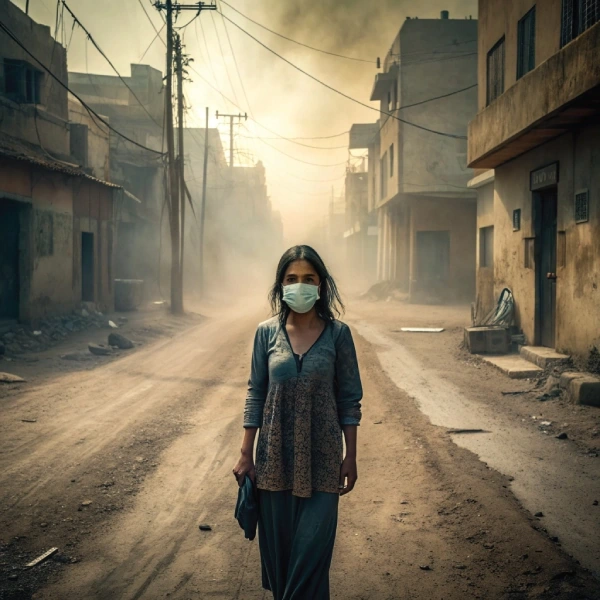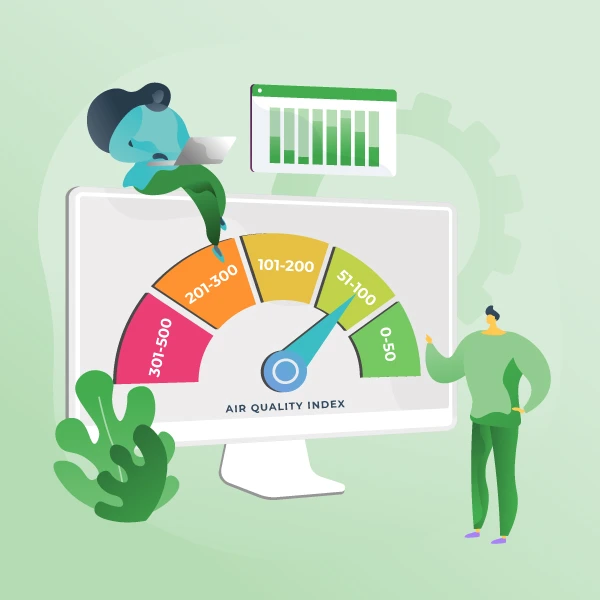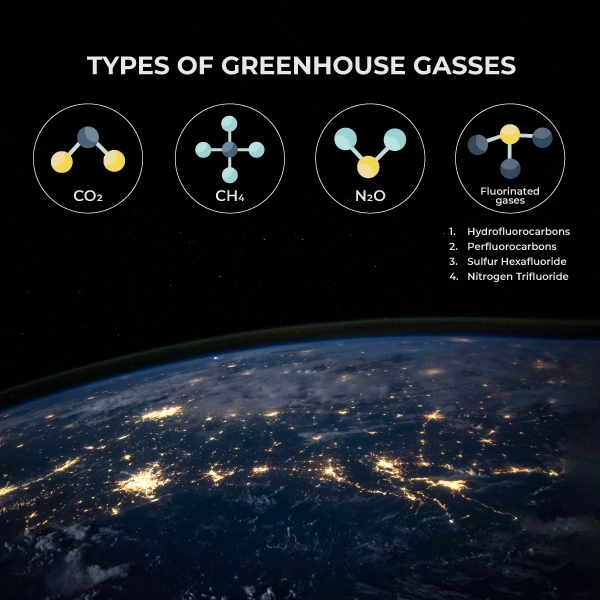Dust storms are frequently thought to be a thing of the past. Or, at the very least, as a problem that only affects desert areas, correct? No, Dust and sandstorms are not limited to those who live near a desert. The perfect storm requires a combination of solid winds and dry ground. A dust storm is a meteorological phenomenon in which high winds transport massive dust or sand particles. It is sometimes called a sandstorm or a haboob (Arabic for the word blown.). It is frequent in arid or desert environments. Dust storms reduce air quality and visibility and may harm health, especially for persons with breathing problems.
The intensity of dust storms (from mild to severe) is affected by many elements, including wind speed, storm duration, and the amount of loose or dry sand accessible in the area. A dust storm causes the clear atmosphere to become hazy, reducing the visibility of the surroundings. Sand and dust storms raise the amount of Particulate Matter (PM2.5) in the air. This increases your chances of having lung and heart problems. Today, we’ll talk about the health effects of dust storms and how to protect oneself from them.

What are the ways dust storms can impact health?
Dust particles vary in size from coarse (non-inhalable) to fine (inhalable) to very fine (respirable). The most severe damage, however, could be to human health, particularly for those with respiratory problems. Tiny dust particles become airborne during a dust storm and can be ingested. Inhaling dust causes a variety of issues regardless of one’s physical state. Here’s a closer look at how these environmental crises harm human health:
- Respiratory Health – In the fight against dust storms, the lungs are on the front lines. Tiny dust particles infiltrate the respiratory system, producing inflammation and discomfort by bypassing our bodies’ natural defenses. This invasion causes symptoms such as coughing and trouble breathing, similar to climbing a sand mountain. Individuals suffering from asthma, bronchitis, or chronic obstructive pulmonary disease (COPD) are particularly vulnerable. Their sensitive airways become even more narrowed, making each breath worse.
- Eyes itching and burning – Another side effect of dust particle exposure is itching and burning eyes. According to a study published in the International Journal of Environmental Research and Public Health, persistent exposure to dust particles can also cause eye problems.
- Skin Problems – Exposure to hazardous particles in the air can cause various skin disorders. “Dust particles and pollutants can strip the skin of its natural oils, making your skin feel dehydrated,” explains Dr Bangia. Then there are allergic reactions that result from these dust particles causing inflammation, allergies, and various types of rashes.”
- Allergic reactions – Dust storms can cause asthmatic individuals to be allergic. Dr. Nagar emphasizes that exposure to hazardous particles might cause allergic reactions, leading to an acute worsening of asthma/asthma attacks. It can potentially cause life-threatening breathing difficulties if left unchecked.
How to protect yourself from dust storms

While we cannot prevent dust storms, we may take steps to reduce their impact on our health. Preventive actions can be implemented where dust storms are widespread to decrease exposure to fine dust particles and prevent dust-related health concerns. Some measures that might help with dust storms include:
An estimated two billion tonnes of fine particles are raised by winds from the world’s dryland soil surfaces every year, affecting 151 countries directly by sand and dust storms The sources of these dust storm areas fall in 45 countries, of which 38 are in Africa and Asia.
A major dust storm in northeast Asia in March 2021 killed 200,000 livestock. It destroyed 121 animal shelters in Mongolia, causing hundreds of flights to be canceled at airports in China and dust health advisories to be issued in South Korea.
Before a Dust Storm
When a storm is approaching, you must take considerable precautions to secure your safety. When a storm comes, it’s time to act fast and prepare for the worst. We may not be able to control the desert winds, but our readiness can turn us from being at risk to being successful. Here’s how you can prepare yourself before a dust storm arrives.
Stay informed
Dust storms are most likely to occur during hot summer under certain atmospheric conditions, and meteorologists can usually forecast their occurrence. Before traveling in hot, dry conditions, listen to local TV or radio broadcasts, check real-time data and consider rerouting or delaying your trip if dust storms are expected. Roadside signs may also be available to warn you of the impending dust storm.
Prepare personal protection
If you live in a storm-prone area, you should always be prepared for a storm. Wear long sleeves and trousers if you will be outside for an extended period. Carry a bag with you, or keep a box in your car’s trunk stocked with stuff you’ll need in the case of a sand or dust storm. Fill the emergency kit with the following items:
- A mask designed to remove tiny particles.
- Completely airtight goggles
- A source of water
- A warm blanket is needed during a winter dust storm, which can swiftly lead to hypothermia.
During a Dust Storm
During a dust storm the following advice can help reduce the effects of a dust storm on your health.
Stay indoors
Staying indoors is critical for persons who are allergic to dust. Close your house door, windows, vents, and other openings to prevent dust from entering your living space. This will keep your home clean of dust particles and provide respiratory protection by ensuring less fine dust.
Protect your eyes and lungs.
Airtight goggles are preferable to spectacles for protection against blowing dust or sand. If you don’t have goggles, cover your eyes and ears with your arm or scarf as you go, then securely wrap a piece of cloth around your head. Moreover, Wearing a mask while going out in a dusty environment can help prevent the entry of dust particles into your nose, however, if you don’t have a mask. It’s best to use a shirt sleeve or a medium-sized sheet. Wrap a bandanna or another cloth across your nose and mouth.
Monitor air quality
Duststorm contaminants can persist in the air for days after they have been released. That is why it is critical to monitor air quality to plan mitigation strategies for good health and the environment. Utilize air quality monitors like Oizom Dust Monitoring, which provides accurate real-time accurate data. It will help you to recognize which particulate matter or dust concerns you need to find a solution for, or chеcking forеcasts can help you plan outdoor activities when dust lеvеls arе lowеr, rеducing your еxposurе.
After a Dust Storm
Following a dust storm, you should take a few steps to clean fine dust and dust particles from around your home and wait for safe conditions if you get stuck with the dust storm outside, ensuring that any remaining dust does not cause future problems.
The air quality will continue to deteriorate as dust storms become more common. Apart from dust and debris, dust storms transport poisons, particle matter, and many other air pollutants. Worse, dust storms mainly composed of PM2.5 can last more than 10 days. That’s because the particulate is lighter and takes longer to settle.
In fact, after a sandstorm:
- Carbon monoxide increases by 84%
- Fine particulate matter by 76%
- Ozone by 40%
- Nitrogen dioxide by 12%
Wait for safe conditions.
Don’t try to move through the storm; it’s much too dangerous. Stay where you are and wait for it to pass before you attempt to move to a different location.
- If you can quickly reach such shelter before a dust storm comes, get there as soon as possible and stay inside. Close all windows and doors and wait out the storm.
- Stick together if you’re with others to reduce the risk of someone getting lost.
Clean up safely
Following are valuable and effective ways to clean your house after a sandstorm strikes your city.
- Vacuum and clean the floors and upholstery
- Wipe surfaces clean
- Wash everything you can
- Use air purifiers
- Manage air conditioner system
- Increase ventilation
For bеst results, usе a vacuum clеanеr with a HEPA filtеr that can trap finе dust particlеs morе еfficiеntly.
Conclusion
Finally, keep in mind that dust storms, while terrifying, may be efficiently addressed with knowledge and preparation. If you live in an area with dust storms that hit the city, people must avoid being exposed to dust particles. However, Increasing dust storms are worsening the current air quality problem. It brings more pollutants into the air, making breathing harder and causing obstructive airway disease, asthma, and other health-related issues. People suffering from health issues should try to avoid outside exposure. But with the right tools and knowledge, we can take the proper steps to protect ourselves from it.
With solutions like Oizom’s real-time air quality monitors, you don’t have to worry about classifying different types of particulate matter. The advanced dust monitor will give you data on all kinds of dust present in the air, promoting you to take smart mitigation actions.
FAQS
Dust storms are difficult to prevent, but their impact can be mitigated. Effective strategies include land management (such as planting vegetation, reducing overgrazing, and sustainable agriculture), implementing measures to reduce dust (such as windbreaks and dust suppressants), and developing early warning systems to monitor environmental conditions.
In the past, people sought protection by building substantial, often underground homes with sealed windows and doors, wearing cloth covers or masks to protect themselves from dust, and storing enough food and water to withstand disruption during severe storms.
Yes, dust storms can lead to health problems. Inhaling dust can worsen respiratory conditions such as asthma and bronchitis, cause eye irritation such as redness and dryness, and increase the risk of infections caused by allergens and pathogens carried by dust particles.
Dust storms vary significantly in duration. Microbursts can last less than 30 minutes, haboobs persist for hours, and dust devils are usually short but disruptive eddies.
Trying to outrun a dust storm is generally not possible or safe. These storms can move quickly and significantly reduce visibility. The safest response is to find shelter inside.
Walking in a dust storm is not safe. The risk of breathing problems and reduced visibility, which can lead to accidents, make it necessary to stay indoors with windows and doors sealed during a dust storm.






